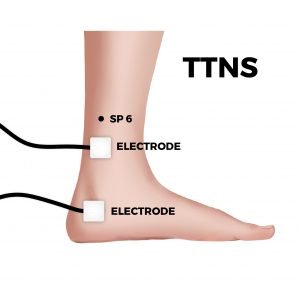Transcutaneous Tibial Nerve Stimulation (TTNS) for Overactive Bladder
non-pharmacological management of
Over-active bladder
Transcutaneous = using surface electrodes on the skin
Tibial Nerve = a nerve that runs down the lower leg
Stimulation = low dose electrical current via a TENS machine
What is OAB?
Overactive bladder (OAB) is a prevalent and bothersome condition, where a sudden urge to use the toilet can't be put off, leading to frequent trips to the bathroom and sometimes bladder leakage.
So why should I consider TTNS?
Evidence-based guidelines recommend lifestyle changes (such as managing fluid intake) and pelvic floor muscle training as first-line therapy, before progressing to medication as second-line therapy. While behavioural and lifestyle interventions are important considerations in managing any bladder problem, they don’t always work enough for everyone. Although drug-based treatments are effective for some people, they often have nasty side effects such as dry mouth and constipation, which can often outweigh the benefits.
So how does TTNS stack up against other treatments?
Studies show that TTNS is safe and effective, with 48-93% of patients achieving significant symptom improvement.
Compared with sham treatment, TTNS leads to a significant reduction in urgency and night-time voiding, and significant improvement in quality of life.
Compared with common medications, TTNS has similar improvements in frequency, urgency, incontinence, pad usage and quality of life. It is generally more acceptable and better tolerated due to lack of side effects. Additionally, it is cheaper in the long-term, and the effects of TTNS are sustained for up to 6 months, whereas the effects of drug therapy cease when you stop taking the drug.
Adding TTNS to standard first-line therapy (bladder training and pelvic floor muscle training) gives much greater improvements in frequency, overnight voiding and incontinence.
How does it work?
The posterior tibial nerve contributes to bladder control. Stimulating the nerve inhibits reflex bladder contractions, which can lead to increased bladder storage capacity and reduced urinary urgency.
The posterior tibial nerve runs down the leg and is close to the skin near the inner ankle. It can be stimulated either by needles ('percutaneous tibial nerve stimulation') which is invasive and expensive (as it requires regular visits to a specialist), or alternatively by surface electrodes on the skin ('transcutaneous'), which can be done at home and thus is much more cost-effective and simpler to use. By placing two electrodes on the inside of the ankle, the posterior tibial nerve can be stimulated.
How do I use it?
Your physiotherapist will set specific parameters on a TENS machine for you to use at home.
Place 2 electrodes on the inside of your ankle (as shown in photo)
Use for 20 minutes daily for 12 weeks plus 'top-ups' if required (or as prescribed by your physiotherapist).
Turn intensity up to the maximum tolerable level
Who can use it?
TTNS can be used for people with OAB symptoms such as:
Urinary urgency
Urinary frequency (day and/or night)
Urgency incontinence
It is often used as 'second-line' therapy for people who have already tried 'standard' treatments such as pelvic floor muscle training, bladder retraining and lifestyle modification.
TTNS should NOT be used if you:
Are pregnant
Have a cardiac pacemaker
Have epilepsy
Have in-dwelling metal in your ankle
Have open ankle wounds
Additional precautions:
Do not use in water
If it becomes uncomfortable, cease use and contact your physiotherapist via phone/email
If you notice redness/irritation of the skin under the electrodes, cease use and contact your physiotherapist via phone/email



